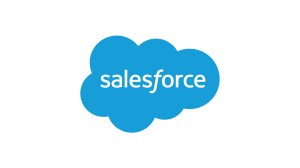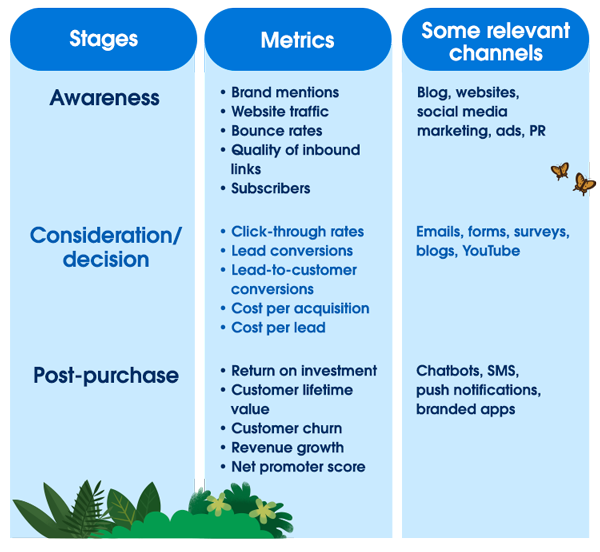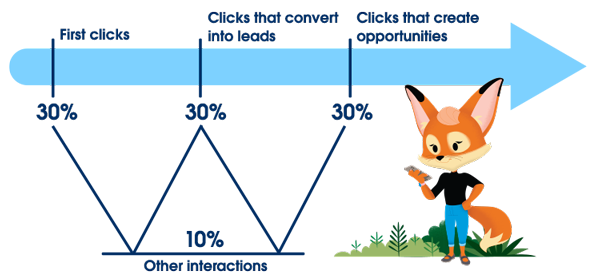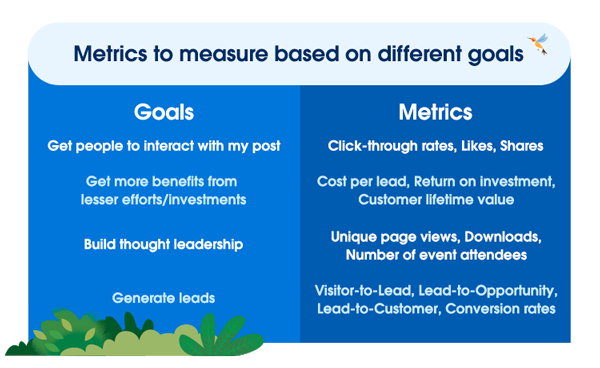How To Use Marketing Metrics To Measure The Success Of Your Outreach



Make every marketing dollar and effort count by measuring and monitoring these marketing metrics along the entire customer journey.

Salesforce India
While creative copy and an attractive design can draw attention, and perhaps appreciation, it is data that helps you turn this attention into measurable value, say a purchase or signup.
With businesses and customers going digital, there’s an abundance of data available to marketers from various sources. Defining and measuring the right marketing metrics make it possible to drill down to what data says about your marketing efforts’ effectiveness.
Table of Contents
How measuring marketing metrics has changed in the last few years
Why is it important to measure marketing metrics?
Examples of common marketing metrics
How your marketers can set their key marketing metrics
Metrics make marketing successful
What are marketing metrics?
Marketing metrics are values marketers can monitor to measure the performance of their campaigns. These values can tell how effectively your marketing efforts are leading audiences to take actions that generate value. But blindly measuring any metric can present a partial or skewed picture of how things really are.
Marketing metrics tell marketers what data to collect and analyse. The marketing metrics you measure should differ based on the channels, goals, and formats of your campaigns. This will reveal finer nuances of the engagement and revenues generated from each campaign over time.
How measuring marketing metrics has changed in the last few years.
Marketers are trying innovative ways to engage rapidly evolving digital-first audiences. This also drives them to adopt a wider range of metrics to measure their marketing efforts’ success. Salesforce’s 7th State of Marketing report says 78% of marketing organisations have reprioritised or changed their marketing metrics in the last year or so.But the marketing function’s underlying goals will always be the same –spread awareness, gain new customers, continue to engage the existing ones.
Metrics like revenue, funnel performance, and customer satisfaction are still the most popular. But KPI-conscious metrics like customer referrals, acquisition costs, engagement with content, etc., are increasingly tracked as well.
Since marketing is more strategic now, its metrics must be in line with overall company goals. 70% of CMOs today align their KPIs and metrics with their CEO’s. There are various intelligent marketing tools today that are helping marketers become more efficient and targeted in their approach.
Why is it important to measure marketing metrics?
As more consumers go online and follow intricate journeys, it becomes harder for marketers to know how they can positively impact their experiences at every touchpoint.
Measuring the right marketing metrics helps marketers know how consumers react to their campaigns and communications. Based on these insights, marketers can amplify the efforts that reap the most benefits, and adjust the ones that are not producing the desired results.
Metrics also help marketers prove the value their efforts add to the organisation. This helps them get bigger budgets and better resources to create a greater impact.
Examples of common marketing metrics
The significance of specific metrics and their benchmarks differ from industry to industry. But there are a few marketing metrics that marketers across industries keep a close eye on at different stages of their customers’ journeys.
Some marketing metrics you can measure at different stages of the marketing funnel and on different channels include:

Here are some common marketing metrics you need to know about:
1. Impression share: Marketers can use this metric to determine how much visibility their brand is getting on a particular channel compared to the larger potential audience it can engage. An increase in impressions can lead to higher sales.
2. Click-through rate (CTR): CTR is the number of times an ad or link is clicked on as a percentage of the impressions. Since ads are “push” campaigns, their CTR is generally low. About 4% or higher CTRs generally indicate that your messaging is relevant and compelling. But to ensure audiences’ journeys progress from here on, it is important to provide experiences that align with the expectations you set.There are manymarketing toolsthat can help you monitor CTRs, some even in real-time so you can optimise campaigns on the go.
3. Lead generation metrics: AI-powered solutions like Marketing Cloud can help marketers track leads generated from multiple marketing channelsin a single, unified dashboard. These leads get prioritised automatically based on the likelihood of their conversion. Popular lead generation metrics include Visitor-to-Lead and Lead-to-Opportunity that measure the conversion of page visitors into ‘warm leads’ and ‘warm leads’ into ‘hot leads’ respectively.
4. Marketing qualified lead (MQL) to sales qualified lead (SQL) ratio: MQLs are those that have shown the intent to buy, and SQLs are prospects that sales teams consider ready for direct contact. Your assets and ads may get several signups or clicks but not all these leads would have a purchase intent.
Before you send your leads to the sales team, follow these steps to ensure they are ready to buy:
- Check the information they have shared
- Discard dummy email addresses
- Verify their LinkedIn profiles
- Make business email addresses mandatory (for B2B)
- Request additional information.
A good MQL to SQL ratio shows that your sales and marketing teams are well-aligned. It reflects a healthy pipeline and how effectively your marketing teams can qualify leads.
5. Cost per lead (CPL): CPL is the amount you spend on gaining a new lead from a campaign or channel. This metric can help you measure the ROI of your campaigns and allocate budgets where you see better results. Ensure that the amount you spend on measures like paid ads and monitoring social media is as low as possible while maintaining high acquisition rates.
6. Lead-to-customer conversion rate: While gathering leads is important for your marketing and sales teams, measuring the number of leads that actually convert into paying customers is also important. This can help you determine whether your sales team needs a greater number of leads, leads of higher quality, or the right content to help them close deals faster.
7. Cost per acquisition (CPA): CPA is the amount you spend to get a new customer. If the CPA is less than the revenue the customer brings in over a period, then your marketing efforts are on the right track. You can calculate the overall CPA of all your marketing efforts or for individual channels to inform budget allocations.
8.Customer lifetime value (CLV): CLV is the amount a customer is expected to spend on your company during the time they are with you. It can include license renewals, product plan upgrades (upsell), and buying your other products (cross-sell) depending on your offerings and pricing model. You can predict CLVs based on similar customer profiles and journeys seen in the past.
CLV is important for proving how often quality is better than quantity in marketing. To maximise revenue, some of your campaigns should always be aimed at better engaging existing customers.
9. Return on investment (ROI): Marketing ROI can be calculated by dividing CLV by CPA. If your CPA is high but CLV is low, you need to tweak your campaign strategy to increase the revenue generated from it.
10.Action completion: Check if your audiences are taking the actions you are leading them towards. It could be actions like entering contact details, subscribing to newsletters, or clicking on a CTA.Action completion for different channels will be measured basis different actions. So, if the action is subscribing to a newsletter, you would measure how many people are subscribing.
11.Multiple touchpoint attribution: Not many people complete a purchase the first time they go browse online. Usually, buyers prefer checking their options and coming back to make the final purchase.To better understand the impact of your marketing efforts at different touchpoints in your customer journey, you can use tools like the W-shaped attribution model. This model attribute 30% credit to first clicks, 30% to clicks that convert leads, 30% to clicks that create opportunities, and 10% to other interactions.

W-shaped Attribution Model
12. Company-focused metrics: Lastly and importantly, knowing how marketers contribute to the company’s business growth and profits is crucial. Company-focused marketing metrics help measure and assess how much of the company’s new or repeat customers, business opportunities, revenue, and profits – can be attributed to the marketing initiatives. Examples of such company metrics include Marketing Originated Customer Percentage, Customer Acquisition Cost recovery time, Return on Marketing Investment (ROMI), etc.
There are also metrics specific to measuring the performance of campaigns on different channels or platforms:
Website metrics
When a person wants to know about your company, the first thing they do is check out your website – read blogs, watch videos, listen to podcasts, and so on. Measuring website traffic metrics is essential to determine how visitors interact with your website and if the website is engaging enough to move them to the next steps. You can track website metrics such as:
- Pageviews: The total number of views that your website pages get over a period. This number includes multiple views from the same visitor. Ideally, pageviews should go up with time.
- Unique pageviews: The number of views your website pages get from individual visitors over a period. The higher is the number, the better is the website experience for visitors.
- Retention rates: Returning visitors indicate interest in content or buying.
- Average time on page: The time a visitor spends on a page on average. While a short duration of 30 seconds or so is not a good sign, a long duration is just as bad, as it means your visitors either find the page too complex or are idle on your page. A duration of 2-3 minutes indicates good engagement.
- Engaged time: Measuring engaged time is a step further from time spent on your web pages. This helps you determine if audiences are actively exploring your content or if your webpage is simply open on a browser.Some marketing tools also use heat maps to determine how much time audiences spend on different parts of your web pages. With insights like this, you can continuously improve the content and structure of your web pages to increase engagement.
- Pages/session: The number of pages a visitor views in a session. A session is an interval between the visitor’s arrival on the website and when they leave it. The more pages they visit during their session, the more attractive they find your content and the more likely they are to progress to the next stage.
- Bounce rate: A “bounce” happens when a new visitor visits a single page on your website and exits immediately without taking any other action. Bounce rates are an indicator of how interesting, relevant, or pleasing the content on your site is to your audiences. Besides this, other factors that can impact bounce rates are content placements, hyperlinks, CTAs, aesthetics, load times, etc. Ideally, your website bounce rates should be below 40%.
Ask yourself if external sites are:
- Relevant to your site
- Considered credible
- Attracting humans or meant for web crawlers (search engine bots that index webpages on the internet)
- Linking to spam sites or selling links
Website conversion rate: It is not enough to only measure the number of people who visit your website. To make the most of your marketing efforts, measure where these visitors are coming from and how many complete intended actions – like making purchases, subscribing to a service, requesting a meeting, etc.
Once you have identified the actions you want to measure, set up custom landing pages that only converted audiences will be taken to. Ensure there is no other way to arrive at these pages, so your calculations stay accurate.
Email marketing metrics
Emails continue to be one of the best ways to reach and engage your audiences. Measure the performance of your email marketing campaigns with metrics like:
- Email open rates: Open rate is the ratio of the number of recipients who open your email to the total number of recipients. A high open rate is desirable, and a compelling subject line usually does the trick.
- Email bounce rate: It is the number of email addresses to which your emails do not get delivered. Hard bounces (typical to fake or non-operational addresses) and soft bounces (caused by temporary issues) should be measured to refine subscriber lists.
- Email click-through rate: Higher click-through rates indicate the effectiveness of your email copy, design, CTAs, etc.
- Unsubscribe rate: Watching subscribers leave can be alarming but approach this positively. When uninterested audiences leave, you are left with subscribers who genuinely want to engage with your brand. This can also reveal important traits of ideal audience segments.
- New subscribers: Understanding subscription patterns can help marketers identify the triggers behind the increased interest in your brand. This is also a content marketing metric that can guide your content marketing and promotion strategies through emails.
- Unengaged subscribers: Just like having inactive followers on social media, unengaged subscribers to your email lists don’t help you in any way. In fact, such subscribers can often give you a false sense of successful brand engagement. To maintain a healthy subscribers list, marketers need to periodically identify inactive audiences and cleanse the list. You can set up automatic unsubscribing to remove unengaged individuals from your list after a decided duration of inactivity and notify them.
Social media metrics
Social media is a great platform for building customer engagement and deeper relationships. But having thousands of followers is no use if they don’t engage with your brand’s content. Indicators like shares/re-shares, likes, comments, pins, etc. are a great way to determine audience engagement rates and sentiment. Social media engagement is one of the most accurate indicators of brand awareness, the other two being brand mentions and branded search.
Let’s look at these metrics in a bit of detail.
- Engagement metrics: Likes, comments, new follows, shares/reshares, tags, etc. indicate active engagement.
- Reach: The number of times your content is displayed, leading to more people seeing them.
- Impressions: The number of people and times your content is shown to your audiences.
- New followers and follower growth rate: You can measure growth by calculating the rate at which your followers increase during a set period.
- Traffic: The amount of traffic your draw to your website through social media platforms.
- Brand mentions: Identifying where your brand gets mentioned can indicate the exposure it is receiving on different platforms. Add to this mention of competitor brands and you’ll find more places your brand can appear.
Then, there are metrics that are used to measure success post-sales.
Retention metrics
To raise your CLV, it is important to dedicate some marketing campaigns towards engaging existing customers. Here are three marketing metrics you can measure to ensure your customers stay connected, loyal, and happy:
- Customer churn: This is the rate at which customers stop buying from you or subscribing to your services. This is particularly critical for businesses that follow a subscription-based sales model.
- Revenue growth rate of existing customers: A rise in this metric shows that your marketing and sales teams are convincing customers to spend frequently or increasingly on your offerings. A fall, on the other hand, should be investigated immediately and addressed,
- Net promoter score: Rated on a scale from 1-10 (scores ranging from -100 to +100), this metric tells you how likely a customer is to recommend your offerings to others.
Once you are familiar with common marketing metrics, it is time to determine which ones your marketers can start measuring.
How your marketers can set their key marketing metrics
The marketing metrics you choose to measure should be relevant to your business, industry, preferred channels, and campaign types. To determine the right marketing metrics to measure your campaign success, follow these two simple steps:
1. Identify your goals: Know what you want to achieve through marketing – whether it is finding more leads, raising CLV, or anything else. Marketing metrics should be directly related to the results you seek.

2. Stay focused: It is natural to want to know all the ways your marketing efforts affect your business. But when you want to see specific outcomes, stick to the metrics that help you measure marketing performance on those lines.
Remember, a lot of your marketer’s time and effort can go into measuring and monitoring marketing metrics. It is best to focus on the essentials, instead of spending time on activities that may not be useful for you at a given point.
Metrics make marketing successful
Marketing metrics act as guardrails for your marketing strategies and activities. They ensure that you’re on the right track with your strategies and budgets and that no effort or marketing investment goes to waste. If you never measure the results at every stage, you’ll never know what you’re doing wrong (or right).
Salesforce Marketing Cloud is a complete solution that can get you started and set you up for success, as all your digital marketing needs can be met in one place. It is driven by an in-built AI engine that helps marketers make data-driven decisions with speed and accuracy.
Click here to learn more about Marketing Cloud’s features.




















